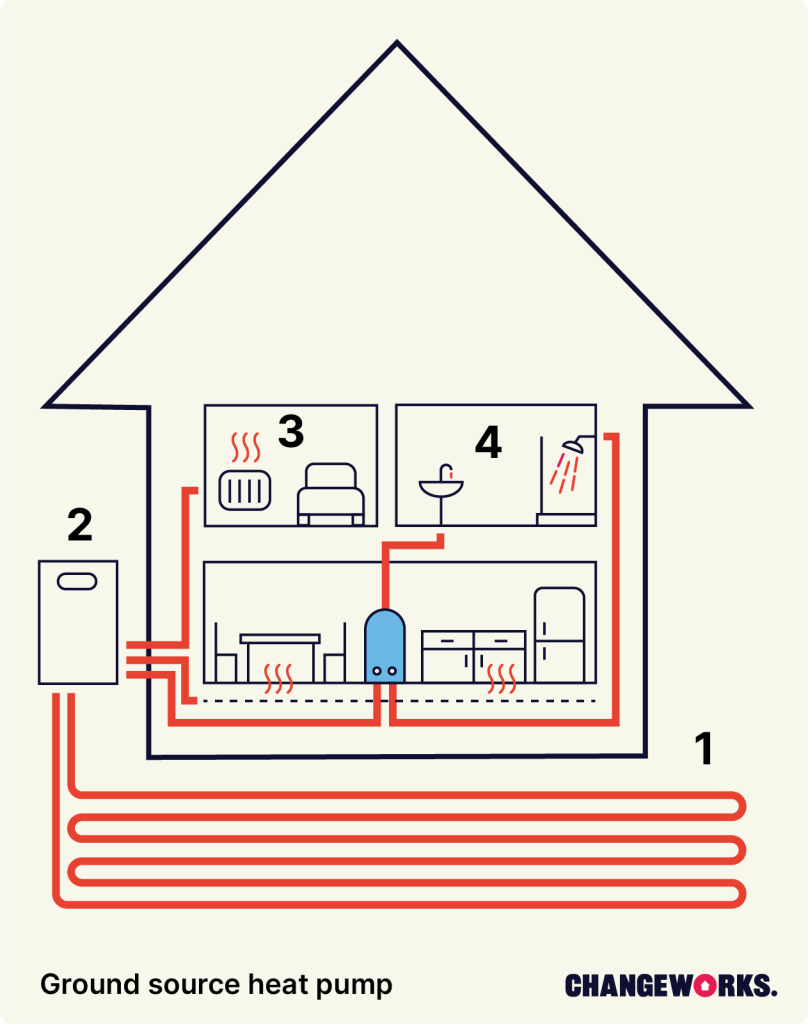Ground Source Heat Pump
Around 70% of our energy usage in the home goes on hot water and heating. Most of this energy comes from burning fossil fuels. This means that, like Air Source Heat Pumps, the Ground Source Heat Pump will play an important in part in Scotland’s net zero strategy.

A Ground Source Heat Pump (GSHP) is a low carbon option for central heating. It takes natural heat from the ground outside and transfers this heat into your home. Depending on the model you choose, a GSHP can also cover your household’s hot water needs.
How does a ground source heat pump work?
A ground source heat pump takes warmth from under the ground outside, boots it, then lets us use this warmth inside our home.
A system of buried pipes collect heat from the ground outside your home.
Since the temperature in the ground stays at a similar level throughout the year, there’s always a reliable source of heat for the system to use.
The GSHP runs on electricity. For every unit of electricity it uses, around four units are transferred to our heating. This means the efficiency of a ground source heat pump is an impressive 400%.
A system of pipes (known as an ‘array’) is buried in your garden. These pipes contain a mixture of water and antifreeze. This ‘brine’ mixture absorbs the heat energy from the ground.
The warmed water moves through the pipes into an evaporator. Inside the evaporator is a refrigerant with a very low boiling point. The heat from the water in the pipes boils the refrigerant, changing it into a gas.
The gas goes through a compressor. This increases the pressure, which in turn increases the temperature of the gas.
The gas moves into a condenser. The condenser contains pipes which feed the central heating. In the condenser, the gas heats the water flowing through the pipes.

1. Pipework (called an “array”) collects heat from the ground
2. Compressor and condenser heat up water in pipes
3. Hot water in pipes is sent to radiators, underfloor heating, and hot water cylinder
4. Water in hot water cylinder can be used for bath, shower, and taps
Ground source heat pump advantages
- Ground source heat pumps are low carbon. If your electricity is renewable, then your GSHP will produce zero carbon emissions.
- A GSHP could help you save significantly on your energy bills. As explained below, this will depend on what fuel you’re currently using and the type of tariff you switch to.
- Grant funding is available to help bring down the cost of installation. See our Grants for ground source heat pumps section below.
Ground source heat pump disadvantages
- Installing a GSHP involves a significant upfront cost. The price will rise further if a bore hole needs to be drilled, or if you need to install new radiators and/or underfloor heating. The good news is that funding is available to help bring down the cost.
- Installing a GSHP is quite a disruptive process. The installer will use machinery to dig up the outdoor space. If you are upgrading your radiators, then this will also involve some upheaval. If you opt for underfloor heating, then the whole floor will have to be taken up.
- You’ll need quite a lot of space. As well as the outdoor space, you’ll need somewhere for the heat pump unit to fit inside. You may also need space for a hot water tank.
Is a ground source heat pump right for my home?
There are several things to think about before switching to a GSHP. We’ll look at the most common considerations below.
Is my home properly insulated?
In most cases, the most effective way to cut your carbon emissions and save money on bills is to make sure your home is properly insulated.
Scottish buildings are notorious for leaking heat from the walls, the roof, and the windows. This means you’re forced to keep the heating on for longer, increasing the cost to yourself and the planet, just to make up for all the warmth that’s being lost.
Insulation limits heat loss whatever type of heating system you have, but it’s especially important when switching to a GSHP. This is because the hot water that a GSHP sends to your radiators is not as quite as hot as the water in a gas or oil central heating system. With an oil or gas boiler, the water running through your radiators is around 60 degrees. With a GSHP system, the water is around 45 degrees.
This lower temperature is still more than enough to keep you warm over winter. It simply means that your home will take slightly longer to heat up. This is why insulation is important. In a poorly insulated home, too much heat is being lost for the room to get up to a comfortable temperature.
It’s difficult to overstate the case for insulation, so we’ve made a number of dedicated guides here. Whether or not you decide to install a ground source heat pump, it’s well worth finding out how insulation can keep your home warmer whilst saving you money.
Do I have space for a ground source heat pump?
On average, the array needs an outdoor area roughly three times the size of your home. The installer will need to be able to get their digging equipment onto the site to put the array in. The land should be clear of trees.
If you don’t have enough space to dig trenches, it may be possible to install the array vertically. This means drilling a bore hole straight down into the ground and inserting the pipes into this hole.
The diameter of a bore hole is about 25cm. The depth can be anywhere from 75 to 200m. Depending on the size of the system, multiple bore holes may be needed.
To make sure the ground is suitable, a survey would need to be carried out.
Whether you choose a horizontal or vertical array, you’ll also need space indoors for the GSHP itself. The ground source heat pump unit is a similar size to a large fridge-freezer. If your ground source heat pump will also be supplying your hot water, then you’ll need somewhere to fit a hot water cylinder. Most ground source heat pumps have their own dedicated ‘plant room’ in a house.
Are my radiators big enough?
A ground source heat pump needs to be part of a ‘wet’ central heating system, i.e. one that sends hot water around your radiators and/or underfloor heating.
As explained above, the water that the ground source heat pump sends to your radiators is about 45 degrees. The radiators in a gas or oil-fired central heating system are designed to receive water at around 60 degrees. This means they’ll usually be too small to work efficiently with a heat pump.
Installing radiators with a larger surface area will allow your GSHP to work efficiently. You don’t necessarily have to switch to larger radiators. It’s possible to choose radiators which are the same size as your old ones but have more panels.
Underfloor heating increases the surface area for heating significantly. This kind of heating can be disruptive and difficult to install in existing homes.
Do I need planning permission for a ground source heat pump?
You won’t usually need planning permission to install a ground source heat pump. However, if you live in a listed building, or your home is part of a conservation area or World Heritage site, planning permission will likely be needed.
It’s worth checking with your local council’s planning department, just to be on the safe side.
Will a ground source heat pump save me money?
As a general rule, whether a ground source heat pump will save you money depends on:
- The type of fuel you’re switching from (e.g. gas, oil, electricity, wood)
- The energy tariff you are on (i.e. how much you’re paying per unit for electricity)
The type of fuel you’re switching from
Most of the heat energy produced comes from the ground (which is free), but there are associated running costs to consider.
Ground source heat pumps use electricity. At its best, the efficiency of a ground source heat pump is 400%. So for every kilowatt of electricity you put in, you get around 4 times that amount of energy out. This is much better than a traditional boiler, which runs at about 90% efficiency.
Ground temperature tends to stay almost the same throughout the year. This means that the efficiency of the ground source heat pump should also be fairly constant.
Even though ground source heat pumps are consistently much more efficient than fossil fuel boilers, this doesn’t automatically make them cheaper to run. This is because, at the time of writing (October 2023), electricity is more expensive (per unit) than gas.
The Energy Saving Trust (EST) have compared the running cost of a ground source heat pump to other types of heating system. The full results are available here.
To summarise EST’s findings:
- Any type of boiler with an energy efficiency rating of G
- Any kind of electric storage heaters
- Coal
- A gas boiler with an energy efficiency rating of A
- An LPG boiler with an energy efficiency rating of A
The tariff you’re on
Due to the energy crisis, there isn’t currently much competition between energy companies. However, when it’s possible to start shopping around again, you should be able to switch to a tariff which is cost-effective for a GSHP.
Some suppliers offer a tariff designed especially for heat pump users, so it’s worth looking out for these.
Ground source heat pumps cost
A ground source heat pump costs around £24,000. This is for the type of heat pump where the array which is buried in horizontal trenches. If the GSHP has a vertical array which is installed using a bore hole, then the average price is £49,000.
The price will vary depending on:
- How big your home is and how much heat it needs
- The make and the size (measured in kilowatts) of the GSHP unit
- Any costs from upgrading your radiators or installing underfloor heating
- How well insulated your home is
Ground source heat pump grants
Grants for ground source heat pumps are available through Home Energy Scotland.
If you are a homeowner looking to install a new GSHP, the grant funding amount is £7,500. There is also the option of a further £7,500 on top of this in the form of an interest free loan.
If you’re a homeowner in a remote or rural part of Scotland, you may be able to get a £9,000 grant for a ground source heat pump. You can also access a further £7,500 through an interest free loan.
For the most up-to-date information about heat pump grants, visit the Home Energy Scotland grant and loan page. Alternatively, you can call Home Energy Scotland free on 0808 808 2282.

Changeworks delivers Home Energy Scotland in the south east and Highlands and Islands on behalf of the Scottish Government and Energy Saving Trust.
As well as providing free, impartial expert advice to thousands of people every month to help them to keep warm in their homes for less, they identify funding opportunities for households seeking to install energy efficiency measures.
For more information, give Home Energy Scotland a call on 0808 808 2282 or email and the team will be happy to help you.